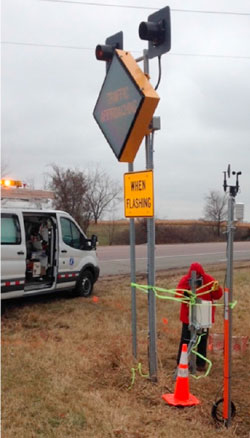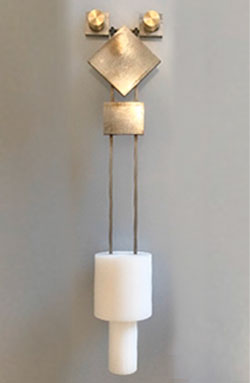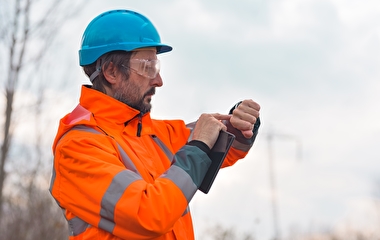Trailer trucks with rear extensions to reduce wind drag have become increasingly common on the highway. With the success of these truck-trailer tails, engineers wondered if the concept could help solve the problem of wind-induced vibrations of road signs as well.
Typically, roadside structures must feature breakaway mechanisms to reduce potential injuries to drivers and passengers, which means the support structures can’t be stiffened. “This makes heavier signs very susceptible to wind-induced vibrations that potentially cause the support structure, and any attached electric signs, to fail prematurely,” says Lauren Linderman, an assistant professor in the Department of Civil, Environmental, and Geo- Engineering (CEGE). In addition, the vibrations may make the signage less visible to drivers.
In a recent project, Linderman led a research team that studied the potential impacts of vibrations on large roadway sign panels, using a MnDOT rural intersection conflict warning sign (RICWS) for analysis. The goal was to understand wind-induced behavior and propose potential sign modifications. MnDOT and the Minnesota Local Road Research Board funded the project.
The researchers focused on two potential modifications. The first modification was the simple removal of the secondary panels behind the flashing yellow lights at the top of the original sign.
“The second idea was motivated by the ability of truck-trailer rear extensions to reduce drag, and involved adding short aerodynamic extensions to the main RICWS panel,” says Dominik Schillinger, a CEGE adjunct associate professor on the research team (now a professor at Leibniz University).
To test the effectiveness of these modifications, the researchers used a computational fluid dynamics (CFD) approach that has been used successfully to calculate pressure on complex sign configurations due to wind loading or passing vehicles. In the first step of the project, researchers set up their CFD model of the rural intersection conflict warning sign, built a smaller, scaled model of the sign, and tested it in the wind tunnel at the U of M’s Saint Anthony Falls Laboratory (SAFL).
In the next step, researchers used the validated CFD model at the field scale to determine the pressure data for the original sign configuration and added it to their mathematical model. Finally, they conducted an analysis to assess the ability of the new sign configurations to improve the sign’s aerodynamic properties.
Based on their analysis, researchers concluded that the modifications to the sign structure were effective. The modifications led to significant reductions of wind drag, turbulent kinetic energy in the wake of the sign, and vibrations of the structure.
“We’ve taken an important first step toward establishing the use of aerodynamic devices for road sign structures,” Linderman says.
“With the research findings and results, MnDOT has made the changes to the geometry of RICWS to reduce the wind-induced dragging force and improve the structure in dynamic resisting properties,” says Jihshya J. Lin, MnDOT bridge evaluation and fabrication methods engineer. “This benefits MnDOT in RICWS service life and in safety to the public.”
The results of this study open up a number of avenues for future work, including optimizing the shape of the rear extensions for different classes of road sign structures and exploring the aerodynamic and vibration response under different wind conditions and directions.
Others on the research team included co-investigators Catherine French (professor) of CEGE and Michele Guala (assistant professor) with the SAFL Hydraulic Lab.




